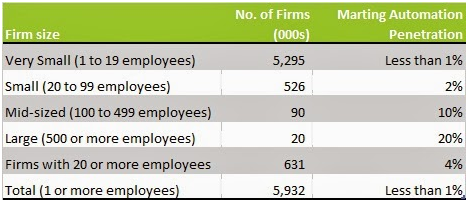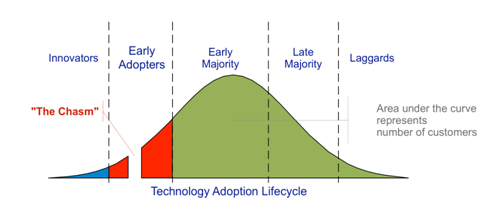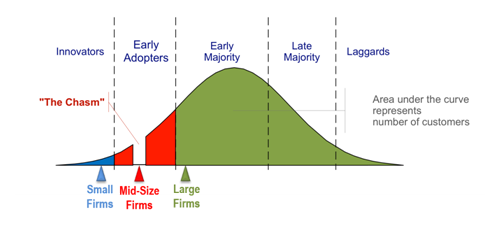Marketers who get inundated with these types of stories get an inflated view of the market penetration of new technologies. But if there is a lot of hot air in these numbers, what can we say about the actual adoption rates of marketing automation software? We delved into this question in our just-published eBook, Marketing Automation: An Industry Overview.
We looked at the total number of businesses in the U.S. but took out the smallest of enterprises – those with not even a single employee. The table below shows marketing automation software use by size of company. Keep in mind there are also over 20 million businesses with zero employees – freelancers, consultants, and other self-employed people, many of whom use email marketing software and could be ripe to upgrade to marketing automation platforms.

Â
In his book, Crossing the Chasm, Geoffrey A. Moore describes a technology lifecycle in which the adoption or acceptance of a new product or innovation proceeds according to the demographic and psychological characteristics of defined adopter groups. According to Moore’s model, the first group of people to use a new product is called “innovators,†followed by “early adopters.†The “chasm†is the crucial period during which a product is either adopted broadly, or remains part of a niche market (or fails). The “early majority†and “late majority†then adopt the product, followed by the last group,
known as “laggards.â€

Â
If this model is applied to the marketing automation sector, it becomes evident that, although the technology is still early in its lifecycle, the chasm is indeed being crossed – at least among large companies.

Â
Figure 2 shows that marketing automation among large firms has crossed the chasm and has now reached the Early Majority stage. By contrast, mid-sized firms are just now crossing the chasm while small firms are still in the Innovators stage. This explains the growing number of marketing automation vendors seeking to gain a foothold into this market, as well as the substantial venture capital the sector has attracted.
What’s especially interesting is why companies are spending the time and effort to cross the chasm. Is the payoff worth the risk? You can read about the compelling case for marketing automation, including capabilities and benefits, in our brand-new Marketing Automation: An Industry Overview eBook.
Dan Freeman of Marketing Growth Strategies has over 25 years of senior level management consulting and marketing experience, working with Fortune 100 organizations as well as small and mid-sized businesses. Dan combines hands-on management experience with advanced knowledge of marketing technologies and all aspects of digital marketing in order to help clients find, get, and keep the right customers to grow their top line.
OK, so you’re hearing a lot about marketing automation. Getting tweets and emails and reading blogs and white papers about how it’s simplifying and transforming the lives of marketers. From all this hype, you might have the impression that everyone who’s anyone in marketing is using marketing automation software. I recently saw a headline claiming that 46 percent of B2B companies use marketing automation. When I read the details, it was clear that the 46 percent represented those that responded to a marketing automation survey. Who responds to a marketing automation survey? Usually those that use marketing automation software. Duh! This was not even remotely representative of the marketplace as a whole.
Marketers who get inundated with these types of stories get an inflated view of the market penetration of new technologies. But if there is a lot of hot air in these numbers, what can we say about the actual adoption rates of marketing automation software? We delved into this question in our just-published eBook, Marketing Automation: An Industry Overview.
We looked at the total number of businesses in the U.S. but took out the smallest of enterprises – those with not even a single employee. The table below shows marketing automation software use by size of company. Keep in mind there are also over 20 million businesses with zero employees – freelancers, consultants, and other self-employed people, many of whom use email marketing software and could be ripe to upgrade to marketing automation platforms.
 All told, there are roughly 50,000 marketing automation installations—less than 1 percent of the nearly 6 million businesses with at least 1 employee. It’s interesting to note that even for the 631,000 companies with 20 or more employees, penetration only stands at about 4 percent today.
All told, there are roughly 50,000 marketing automation installations—less than 1 percent of the nearly 6 million businesses with at least 1 employee. It’s interesting to note that even for the 631,000 companies with 20 or more employees, penetration only stands at about 4 percent today.
In his book, Crossing the Chasm, Geoffrey A. Moore describes a technology lifecycle in which the adoption or acceptance of a new product or innovation proceeds according to the demographic and psychological characteristics of defined adopter groups. According to Moore’s model, the first group of people to use a new product is called “innovators,†followed by “early adopters.†The “chasm†is the crucial period during which a product is either adopted broadly, or remains part of a niche market (or fails). The “early majority†and “late majority†then adopt the product, followed by the last group,
known as “laggards.â€
 Figure 1: Technology Adoption Lifecycle from Crossing the Chasm
Figure 1: Technology Adoption Lifecycle from Crossing the Chasm
If this model is applied to the marketing automation sector, it becomes evident that, although the technology is still early in its lifecycle, the chasm is indeed being crossed – at least among large companies.
 Figure 2: Current State of Marketing Automation Adoption by Firm Size
Figure 2: Current State of Marketing Automation Adoption by Firm Size
Figure 2 shows that marketing automation among large firms has crossed the chasm and has now reached the Early Majority stage. By contrast, mid-sized firms are just now crossing the chasm while small firms are still in the Innovators stage. This explains the growing number of marketing automation vendors seeking to gain a foothold into this market, as well as the substantial venture capital the sector has attracted.
What’s especially interesting is why companies are spending the time and effort to cross the chasm. Is the payoff worth the risk? You can read about the compelling case for marketing automation, including capabilities and benefits, in our brand-new Marketing Automation: An Industry Overview eBook.
Dan Freeman of Marketing Growth Strategies has over 25 years of senior level management consulting and marketing experience, working with Fortune 100 organizations as well as small and mid-sized businesses. Dan combines hands-on management experience with advanced knowledge of marketing technologies and all aspects of digital marketing in order to help clients find, get, and keep the right customers to grow their top line.
CALENDAR
CATEGORIES
TAGS
TWITTER POSTS
CALENDAR
- powered by
- One Big Broadcast
- creative by
- WebStager
© 2024 One Big Broadcast | All rights reserved
